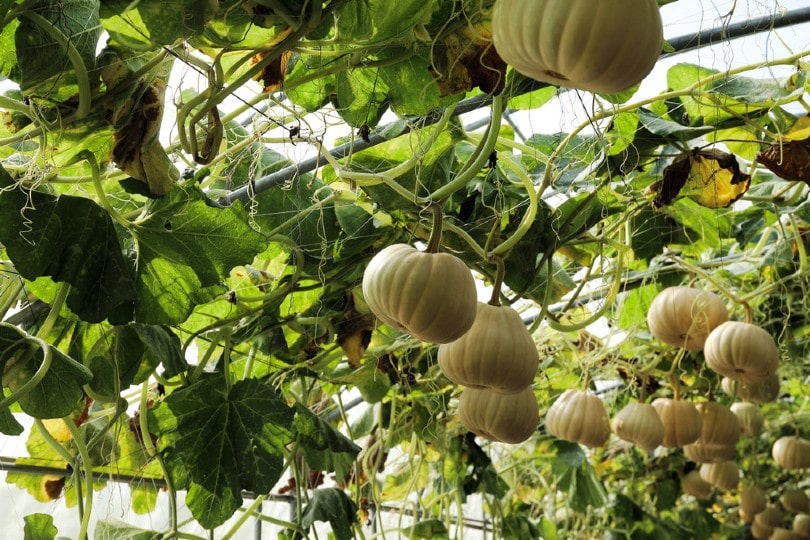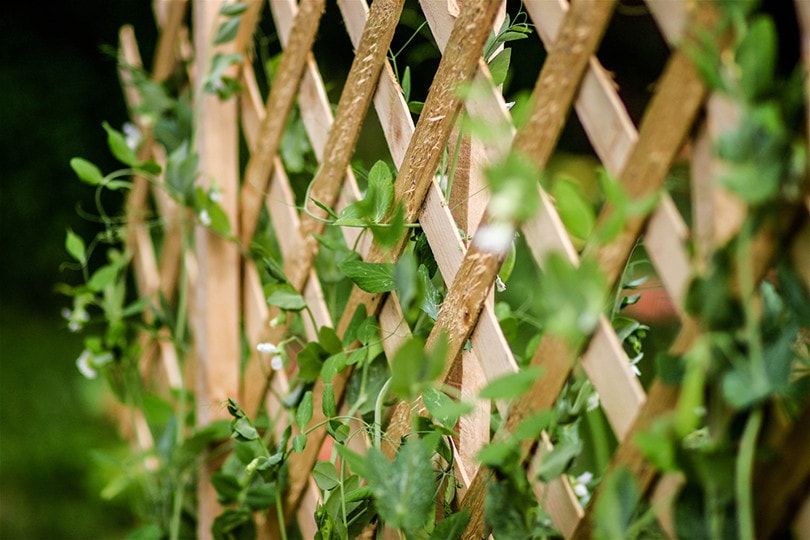Does Squash Need a Trellis? Steps, Types & Benefits
-
Kristin Hitchcock
- Last updated:

Squash doesn’t need a trellis. However, there are many benefits to growing squash vertically, so this method is often the one used by gardeners. Of course, growing squash vertically can be a bit much if you’re growing it large scale. Preparing hundreds of plants for vertical growing would be very labor-intensive. However, nudging a dozen plants onto a trellis is a different story.
When grown directly onto the ground, squash can take up a lot of space. However, you can grow it vertically on a trellis with very little space at all. In smaller plots, growing squash usually has to be done vertically for this reason.
Luckily, prompting squash plants to grow vertically is not terribly difficult. All you need is a vertical structure and some extra prompting. Below, we’ll work you through all the steps necessary to grow squash vertically.
The 7 Steps to Grow Squash Vertically
1. Choose a Good Location
The first step to high-yield veggies is planting your squash in a suitable location. Any location that is suitable for growing squash on the ground is typically also suitable for growing squash vertically. However, you do want to set up the trellis in a way that does not cast a shadow over other plants. Typically, the easiest way to do this is by putting it in the north portion of the garden.
As the sun stays in the southern part of the sky, placing the trellis in the north prevents it from casting long shadows over the rest of your garden.

2. Install the Trellis
Now that you know where to put your trellis, it’s time to install it. There are many options you can use for a trellis. Often, squash can grow on a trellis made from wiring, lattice woodwork, or even PVC. Of course, you can also purchase commercial options.
Be sure to install the trellis solidly into the garden. You want the posts as far into the ground as possible but be careful not to damage the roots of other plants while you’re doing so.
3. Plant the Squash
Next, you’ll want to plant your squash near the trellis. Plant each squash plant on the base of its own structure. Be sure to allow enough room between the plants so that their roots have enough room to grow. The squash will largely be growing on the trellis otherwise.
4. Add Extra Supports
We recommend utilizing extra supports if you use a weaker trellis. Some commercial trellises are made for plants like tomatoes. These usually cannot hold up squash plants, as they are much heavier. In these cases, add more wooden posts to the trellis to ensure that it can withstand the weight of the plant.

5. Train the Squash to Grow Up the Trellis
Now that the squash is planted, you’ll usually have to train it to grow onto the trellis. Rarely, a squash plant will just do what you want it without any training, but you will need to train your plants in most cases.
Luckily, this is pretty easy. As the squash plant grows tall and begins to vine, simply tie it to the trellis. Wrap it around in a manner that resembles a vine climbing. Typically, the plant will retain this position as it grows. Once the vine grows more, move the ties up towards the top. Keep doing this while the plant grows to ensure that it continues to climb up and doesn’t go back to the ground.
6. Take Care of Your Plants
For the most part, you’ll want to take care of the squash plants like you normally would. Ensure that they receive enough water, and consider adding some mulch. Without any leaf coverage on the ground, the plants may dry out sooner than they would otherwise. Therefore, be moderately careful regarding watering. You may need to water more than you’d expect.
7. Trim Tall-Growing Vines
Sometimes, the vines may grow a bit too long. You want your plant to grow full as well as up, so be sure to trim any too-tall vines that begin to overgrow the trellis. Keeping the plant trimmed will ensure that its energy is diverted to growing out instead of just up.
The Benefits of Growing Squash Vertically
When you grow squash vertically, it does take a bit more work. You have to install and maintain the trellis, as well as train the plant to grow upwards. However, there are many benefits to growing squash in this manner. Here are just a few that typically lead to better squash plants.
- Takes up less space. One of the biggest benefits of growing squash on a trellis is that they take up much less space. When you have a very small space, this factor can be extremely helpful. It makes it possible to grow squash in a very small garden.
- Improves sun exposure. When leaves are lifted up and spread on a trellis, there is more sub penetration. Therefore, your plant will get more energy from the sun.
- Prevents fruit rot. Squash on the ground can get wet, which often leads to rotting. Therefore, to prevent rot, we highly recommend growing them on a trellis.
- Fewer diseases. Without touching the ground, squash plants are less prone to pests and diseases.
- Improved air circulation. When raised above the ground, more air will penetrate your plant. This improved air circulation helps prevent mold and mildew from forming, which can seriously harm your plant in some cases.

Squash to Grow on a Trellis
There are several types of squash that can grow on a trellis. Heavier varieties often cannot grow well on a trellis without extra help, as the fruits will fall off before they ripen completely. You can grow these in some cases, but you will need a hammock for the developing fruit.
However, there are some squash varieties that grow very well on a trellis, such as:
- Yellow summer squash: This bright yellow squash can grow quite well on a trellis, as their smaller size allows them to ripen before falling. However, you should still aim to harvest them before they get too large.
- Zucchini: Very similar to yellow squash, zucchini is a similar size. Therefore, it also does good on a trellis. It can get quite large, so be sure to harvest it before it becomes too big.
- Acorn squash: While this squash looks rather large, it is actually extremely light and so does well during vertical farming. Plus, it is one of the few winter squashes that fall into this category.
- Delicata squash: If grown for long periods, this squash can get large. However, they ripen quickly, so they are easy to harvest before they fall.
Conclusion
Squash can often be grown on a trellis. Setting them up for vertical growing is quite easy. All you need is a trellis that can withstand the weight of a squash plant and many plant ties. As the squash grows, tie the vines to the trellis so that it climbs instead of spreading on the ground. While this does take a little bit of remembering, the work is rather easy.
There are several benefits to putting in this little bit of extra work. On top of taking up less room, squash plants grown vertically are also healthier, and their fruits are much easier to harvest.
Of course, some varieties of squash simply cannot grow on a trellis, as their fruits are too heavy. Therefore, we only recommend lighter, smaller squash plants for vertical growing. Butternut squash and similar varieties will fall before they ripen unless you place a hammock underneath the fruits.
See also:
- Does Eggplant Need a Trellis? How to Grow Eggplant Vertically
- Are Fords Reliable? Are They the Right Car for Me?
Featured Image Credit: topimages, Shutterstock
Contents

